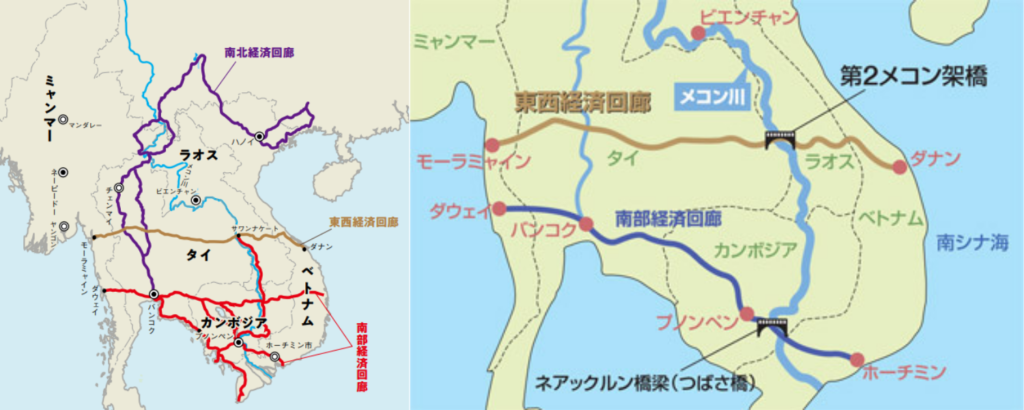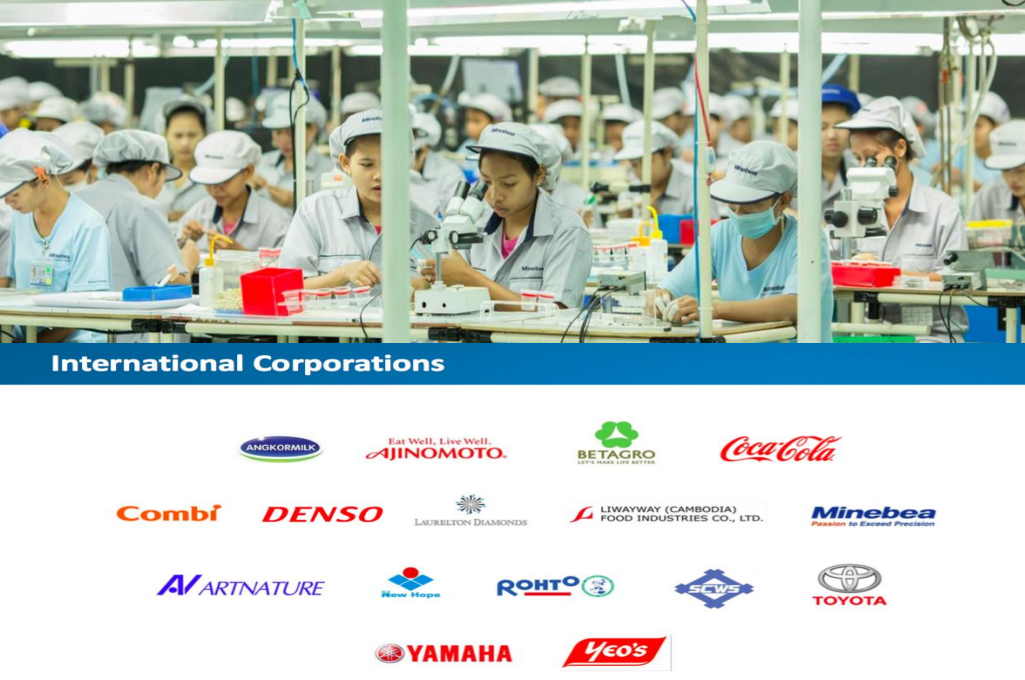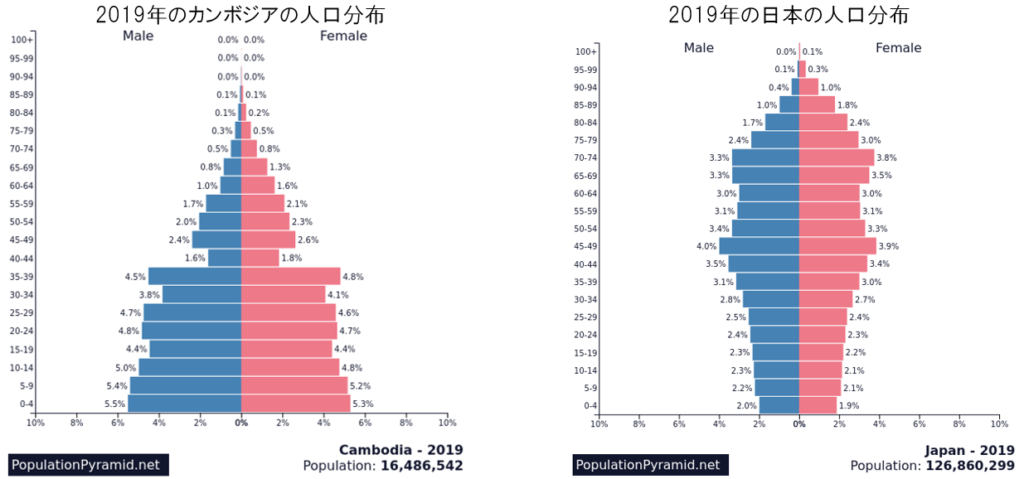Good location with economic circuit, open ocean and Mekong River
Cambodia is located in the center of the five ASEAN countries on land. The capital of Cambodia, is located in the center of Ho Chi Minh, the largest city in Vietnam, with Bangkok, the capital of Thailand, it is connected by an industrial road called the “Southern Economic Corridor,” which currently extends to Myanmar. The southern part of Cambodia faces the open ocean, and the Sihanoukville International Port is the base for maritime trade.
The Mekong River, which runs through Cambodia, passes through the capital Phnom Penh, and the Phnom Penh Autonomous Port (PPAP) is responsible for river trade. Cambodia, Thailand, Vietnam, Myanmar and Laos, which are the five countries in the Mekong River basin, have formed the Mekong Economic Zone and are accelerating the expansion of domestic and foreign companies. This favorable location will increase the likelihood that Cambodia will gain the potential to compete with its neighbors as a country for economic development in the ASEAN Economic Community (AEC).

Economic growth that doubles salary in more than 10 years
In Cambodia, the GDP growth rate for the last 10 years has remained at a high level of 7% every year, and the recovery after the Lehman shock (The global financial crisis ) was also remarkable. Labor force, purchasing power, and consumption have all increased steadily, which is one of the highest growth rates in Southeast Asian countries and is said to be unprecedented in the past. In Cambodia, which is sandwiched between Thailand and Vietnam of China Plus One, foreign-affiliated companies focusing on low labor costs will shift some of their production bases from around 2010, “China Plus One” or “Thai Plus One” The movement has become more prominent, and the number of Japanese companies entering the market has increased.
Many foreign companies have entered the Cambodian market, reflecting rapid economic growth and stable political conditions. One of our strengths in Cambodia is that we can receive tariff reductions and exemptions by using the ASEAN Trade Agreement on Goods (ATIGA), Japan / ASEAN FTA, China / ASEAN FTA, etc. In addition, from the perspective of foreign companies and foreign investors, Cambodia, where US dollars can be used, is an investment destination with low exchange risk. We are promoting economic growth by developing hardware and software infrastructure.

Average age 27 years old, about half of the population is 30 years old or younger
The population of Cambodia is 15.502 million (Cambodia Population Renaissance Survey 2019, other overseas working population is 1.236 million), and the average age announced in 2021 is as young as 27 years old (Japan is the world’s top 45 years old). About half of them are under 30 years old. The population growth rate is 1.4% per year, and it is said that the population explosion has just begun and will continue until at least 2045.

The beautiful pyramid-shaped population is about 29.4% for the young, about 61.7% for the working age, and about 8.9% for the elderly (the ratio of people aged 65 and over in Japan is 28.4%). The chance of high growth is known as “when the proportion of children decreases and the working age population increases”, but in Cambodia, the young population decreased by 4.3 points and the working age population decreased by 1.7 points from the same survey in 2008. With the increase in point, it can be said that the time has just come.
The labor force is about 10.9 million and will continue to grow rapidly. The population of the capital Phnom Penh is 2.13 million, and the urban population ratio is still low, and it is expected that the population will flow into urban areas in the future. The benefits of the demographic dividend in the future and the accompanying increase in the purchasing base are expected, and it is full of potential for “growth of economic development”.

You can live, deposit, do business, and invest in US dollars
You can use the US dollar (USD) in most aspects of your life in Cambodia. It is compatible with the home currency Riel (KHR), and prices are listed in both currencies in the city. You can use US dollars not only for daily shopping, but also for receiving salaries, depositing in banks, purchasing and investing in real estate, and establishing a local corporation. While many countries are often restricted to their own currency, no other country in Asia can use the US dollar as much as their own currency.
In Cambodia, even non-residents of foreign countries can open an account denominated in US dollars, and there are several banks that can make time deposits at a high interest rate of 6% or more per annum. With the progress of cashless payments in Cambodia, it is possible to conveniently make payments using QR codes and very fast remittances using bank apps. Since Cambodia has almost no foreign currency restrictions, it is important that there are no restrictions on taking out funds overseas as a final exit.
Now, more than 90% of the distribution amount is in US dollars and the US dollar rate in deposit accounts is more than 90%, and being able to live, deposit, invest and do business in US dollars is attractive to companies and people in many countries.
Can speak English
The official language of Cambodia is “Khmer” and the characters are “Khmer”. The grammar is the same as in English, but the characters are not familiar to Japanese people. Locals talk in Khmer, but most urban areas in Cambodia can speak English wherever they go. It is usually written in English along with Khmer, and the fact that English is understood is very attractive for living and doing business.
In Cambodia, there are many people who relearn English for work, and especially in Phnom Penh, the capital city where multinational companies are expanding, there are many trilingual people who speak a third language in addition to English. Compared to neighboring countries with higher GDP than Cambodia, English is much easier to understand. However, official documents are in Khmer, and pen ink is basically blue.
Easy to get a visa
In Cambodia, there are no requirements such as high cost to obtain a visa or a certain amount of deposit. Cambodia has an entry visa and a stay visa, and foreigners need to obtain an entry visa. Anyone can easily obtain an entry visa, so staying in Cambodia for less than 30 days will not be a problem, and for short-term business trips and sightseeing, an entry visa will suffice. If you plan to stay for more than 30 days, you will get a stay visa. This stay visa is also obtained for those who work locally or for long-term stays such as studying abroad. There are four types of stay visas: business, job seekers, retirement, and students, but the most common is the business visa. You can extend your stay for up to one year as many times as you like by attaching the necessary documents.

The hurdle for establishing a corporation is low
It is possible to establish a 100% foreign-owned corporation in Cambodia. A local corporation can be established from one foreigner. Foreign capital regulations are loose, and there are no restrictions on remittances overseas, making it easy for foreign companies to enter. Cambodian law is basically designed to encourage investment and must be treated without discrimination from domestic corporations, except for land ownership. Therefore, it is open and free to enter in many fields.
Corporate accounts can also be opened in dollars with less risk of foreign exchange, foreign currency holdings and transactions are free in Cambodia, and there are no restrictions on the amount of foreign currency brought in or taken out. Therefore, it is possible to borrow or lend business funds in your own country and send them to Cambodia.
Cambodia has a system called “prepaid corporate tax” that requires monthly declaration and payment of 1% of monthly sales, but Prime Minister Hun Sen, who came to Japan in May 2019, declared the system to be abolished. Therefore, if it is realized in the future, there is no doubt that the barriers for Japanese companies to expand into Cambodia will be further lowered.
Infrastructure development and government support
In Cambodia, planned infrastructure development such as roads, water and sewage, electricity, and telecommunications is proceeding at a rapid pace, and large-scale development has started one after another in collaboration with the government and the private sector. The development of Cambodia is based on a government-led master plan. It is said that the plans of developing countries are changeable, but the Cambodian master plan has been steadily progressing until now, and it cannot be said unconditionally.
Phnom Penh, which has undergone rapid urbanization over the past decade, has also needed to expand its city to accommodate economic development and population growth. In 2010, the district (Khan), which was 7 districts, was divided and newly established, and the current Phnom Penh is now 14 districts and the area has doubled from 376.17㎢ to 678.46㎢, which is almost the same size as the 23 wards of Tokyo. Although the urban population is increasing, the influx of population into Phnom Penh continues even from the still low urban population rate. The current Phnom Penh is trying to become a sub-center around the center, and the 2035 Master Plan suggested further expansion of Phnom Penh.